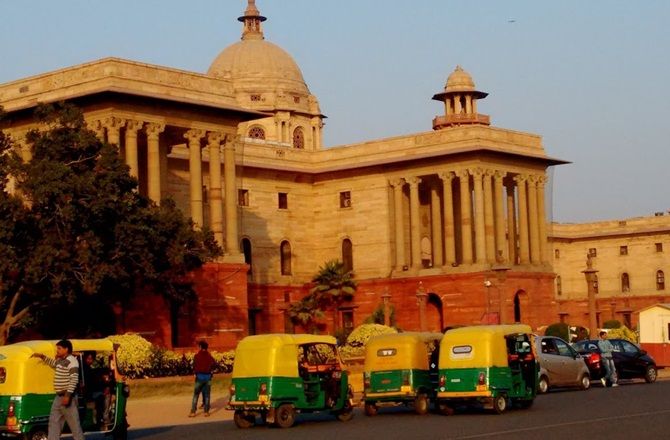In its manifesto for the 2014 Lok Sabha elections, the Bharatiya Janata Party (BJP) had criticised the Congress-led UPA regime for “policy and decision paralysis”.
 One of the first decisions of the Prime Minister Narendra Modi-led government was scrapping the unwieldy groups of ministers (GoMs) and empowered GoMs that had been accused of worsening “policy paralysis” of the United Progressive Alliance (UPA).
One of the first decisions of the Prime Minister Narendra Modi-led government was scrapping the unwieldy groups of ministers (GoMs) and empowered GoMs that had been accused of worsening “policy paralysis” of the United Progressive Alliance (UPA).
But now, they are back - albeit informally.
In its manifesto for the 2014 Lok Sabha elections, the Bharatiya Janata Party (BJP) had criticised the Congress-led UPA regime for “policy and decision paralysis”.
The nine GoMs and 21 EGoMs - which, according to some observers, had become living proof of the indecision that plagued the former prime minister Manmohan Singh-led government - were dismantled on May 31, 2014.
Two years into the Modi government, these panels are back. But they are leaner, thinner and, most importantly, effective in an informal format.
The concept was by the former Prime Minister Atal Bihari Vajpayee-led government (1998-2004) It was consolidated by the Manmohan Singh governments (2004-14).
Now, in their new avatar, they are “informal” and issue-specific, constituted and dissolved on the basis of immediate requirements, without much paperwork.
This has resulted in quicker decision making, and there are no elaborate mechanisms.
Also, the number of these informal GoMs, or iGoMs, changes from time to time.
Some were formed soon after the government was sworn in for looking into Ganga rejuvenation and fast-tracking environment clearances.
Typically, iGoMs, are made up of three-four ministers.
They meet as often as required, brainstorm and send their recommendations for approval, depending on the nature of the subject, to the Cabinet or the Prime Minister’s Office.
Initially, the iGoMs had started tentatively but have been found to be a great tool to broad base decision making, that too without wasting time.
Of late, the government has put much emphasis on iGoMs, nearly taking every key decision or initiating consultations through this route.
Some reports claim there are about 60 iGoMs, but government sources said the figure is more conservative.
Although, there is one similarity to the UPA: then, Pranab Mukherjee, now the President, headed most of the EGoMs and GoMs; now, Finance Minister Arun Jaitley who heads most of the informal groups.
“It is an informal and fluid arrangement. No fixed date is set for ministerial panels to meet. The iGoMs are known to meet anywhere even at short notices,” an official said.
Key ministers are known to drive down to meet their counterparts to resolve an issue, or, if travelling, even speak with each other via teleconference.
An iGoM was recently constituted to oversee the Centre’s directive to fertiliser companies to lower non-urea rates in the interest of farmers.
The panel was formed after reports emerged in the press that some fertiliser companies were not willing to follow the Centre’s directive to lower rates during the ongoing kharif season.
The iGoM comprised Fertiliser Minister Ananth Kumar, Agriculture Minister Radha Mohan Singh and Urban Development Minister M Venkaiah Naidu.
The iGoM met just days after the companies refused to lower the rates and gave a deadline by which all companies would have to follow the directive or else penal action could be taken against them.
“It is these decisions and actions which an iGoM is required to take to quicken the process,” another official said.
The iGoM had to meet early as time was running out because any delayed response would have meant farmers would not get the benefit in the kharif season.
Earlier, the GoMs would take days to fix a meeting and more time to come to a conclusion as lots of procedures had to be followed and availability of ministers ensured.
There have been iGoMs on price rise, sugar, pay commission, fertiliser prices, and even how to celebrate the Independence Day.
People in the government also point that iGoMs have prevented inter-ministerial turf wars.
An official said there were times during the UPA rule when one ministry had taken the other to court.
UPA’s EGoMs/GoMs led to copious paperwork and files that eventually became public under the Right to Information Act and the basis of evidence in cases like 2G and coal scam.
But officials said the perceived lack of accountability of iGoMs need not be overstated as final decisions were taken by the Cabinet or the PMO.
The UPA’s GoMs and EGoMs were thought to have crippled ministries and departments.
Modi’s PMO in its press statement on 31 May 31, 2014, termed “abolition” of the GoMs/EGoMs a “major move” to empower the ministries and departments.
It said the move would “expedite” the decision making process and “usher in greater accountability in the system”.
“Whenever the ministries face any difficulties”, it said, “the Cabinet Secretariat and the PMO will facilitate the decision making process”.











